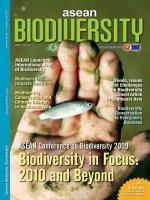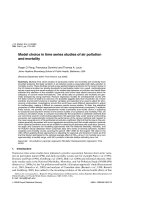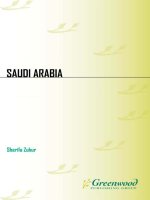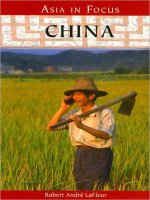china (asia in focus series)
Bạn đang xem bản rút gọn của tài liệu. Xem và tải ngay bản đầy đủ của tài liệu tại đây (10.85 MB, 525 trang )
CHINA
Titles in ABC-CLIO’s Asia in Focus Series
China Robert André LaFleur, Editor
Japan Lucien Ellington, Editor
The Koreas Mary E. Connor, Editor
CHINA
Robert André LaFleur, Editor
Asia in Focus
Copyright 2010 by ABC-CLIO, LLC
All rights reserved. No part of this publication may be reproduced, stored in a retrieval system,
or transmitted, in any form or by any means, electronic, mechanical, photocopying, recording,
or otherwise, except for the inclusion of brief quotations in a review, without prior permission in
writing from the publisher.
Library of Congress Cataloging-in-Publication Data
China / Robert André LaFleur, editor.
p. cm. — (Asia in focus)
Includes bibliographical references and index.
ISBN 978-1-59884-166-4 (hardcover : alk. paper) — ISBN 978-1-59884-167-1 (ebook)
1. China—History. I. LaFleur, Robert André, 1959–
DS706.C48724 2010
951—dc22 2009034580
14 13 12 11 10 1 2 3 4 5
ISBN: 978-1-59884-166-4
E-ISBN: 978-1-59884-167-1
This book is also available on the World Wide Web as an eBook.
Visit www.abc-clio.com for details.
ABC-CLIO, LLC
130 Cremona Drive, P.O. Box 1911
Santa Barbara, California 93116-1911
This book is printed on acid-free paper
Manufactured in the United States of America
v
Contents
About the Editor and the Contributors, xi
Introduction , xv
1 GEOGRAPHY, 1
Robert André LaFleur, Warren Bruce Palmer
The Physical Setting and China’s Population , 1
Geographical Regions , 4
Land, Agriculture, and the Laojia , 8
Coming to China: Invasion and Tribute , 10
Themes in Chinese Geography , 12
Imaginative Geography , 17
2 HISTORY , 21
Robert André LaFleur
Archaeology , 21
Foundation Myths and Early History (to c. 1100 .. .) , 22
Charting the Rise and Fall of China’s Dynastic Tradition—
Sima Guang’s Perspective , 26
The Zhou Dynasty (c. 1100–221 .. .) , 28
The Qin Centralization (221–206 .. .) , 30
The Han Dynasty (206 .. .– 220 . .) , 33
Contents
vi
|
The Period of Division (220–589) , 36
The Sui Dynasty (581–617) , 37
The Tang Dynasty (618–906) , 38
The Five Dynasties (907–959) and the Kingdoms of
Liao, Xi Xia, and Jin (c. 900—1234) , 41
The Northern and Southern Song (960–1279) , 42
The Mongols and the Yuan (1234–1368) , 44
The Ming Dynasty (1368–1644) , 47
The Qing Dynasty to 1800 , 49
The Early 19th Century—Stasis, War, and Diplomacy (1800—1850) , 52
Rebellion and Beyond (1850–1870) , 54
Attempts at Restoration and the Fall of Qing (1870–1911) , 55
Republican China and the War Years (1912–1949) , 58
The People’s Republic of China (1949–Present) , 61
Notes , 64
3 POLITICS AND GOVERNMENT , 67
John A. Rapp
From Traditional to Modern: The 20th-Century Chinese State , 67
Themes from Communist Systems , 70
Combining Traditional and Communist System Models , 71
Ideology , 72
Party-State Structure , 83
Domestic Policy: Human Rights and Dissent , 90
Foreign Policy: China and Global Politics , 92
Greater China Issues , 98
4 THE MODERN CHINESE ECONOMY , 103
Warren Bruce Palmer
China’s Traditional Agricultural Economy , 105
The Chinese Economy, 1900–1949 , 114
China’s Economy: The Mao Era, 1949–1978 , 117
Economic Reform, 1979–1989 , 129
The Chinese Economy Today , 134
Resources , 134
China’s Economic System , 141
Intellectual Property Rights , 144
China’s Financial System , 148
China’s Trading Partners and China’s Trade Balance, 153
5 SOCIETY , 163
Robert André LaFleur, Tamara Hamlish
Religion and Thought , 163
The Hundred Schools of Thought (c. 700–200 .. .) , 167
Buddhism and Religious Daoism During the Period of Division
(c. 200–600 . .) , 172
Contents
|
vii
Neo-Confucian Thought , 175
Religion, Thought, and the Power of Gathering , 178
Social Classes and Ethnicity , 182
People , 182
Wealth, Class, and Status in Chinese History , 185
Wealth and Status in Contemporary China , 189
Ethnicity and Outlying Peoples in Early Chinese Thought , 190
Ethnic Minorities in Modern China , 192
Women and Marriage , 194
Women in Chinese Society , 194
Marriage and Family in Traditional China , 196
Traditional Marriage and Family Life , 199
Women in Contemporary China , 203
Education , 206
Language and Locality , 206
Education and Acculturation , 208
Traditional Education , 209
Contemporary Education , 212
Educational Curricula , 214
Education in Taiwan and Hong Kong , 215
Educational Challenges , 218
6 CULTURE , 221
Chinese Language , 221
Shin Yong Robson
The History of Written Chinese , 221
Formation of the Characters , 224
Simplifi ed Characters , 226
Problems of Simplifi cation , 228
Pronunciation , 233
Phonetic Writing (Romanizational) Systems:
Peking or Beijing? , 234
Mandarin versus Dialects , 235
Useful Chinese Expressions , 236
Social Relationships and Etiquette , 238
Tamara Hamlish, Warren Bruce Palmer, Robert André LaFleur
Nested Boxes , 238
Social Relationships— Guanxi , 239
Social Relationships—Family , 240
Social Relationships—Beyond Home , 242
Social Relationships—Practical Etiquette in Chinese
Social Situations , 244
Contents
viii
|
Literature , 250
Daniel Youd
Introduction: Continuity, Discontinuity, and Diversity , 250
The Classic of Poetry , 250
The Songs of Chu , 251
Early Prose , 253
Han Dynasty Poetry , 255
One Poet from the Period of Division: Tao Qian , 257
Two Poets from the Tang: Li Bo and Du Fu , 258
Cí Poetry of the Song Dynasty , 261
Fiction: Tales and Short Stories , 263
Drama , 265
Ming and Qing Novels , 266
The Modern and Contemporary Periods , 267
Chinese Art , 270
Kenneth S. Ganza
Chinese Art and the Supernatural World , 271
Nature in Chinese Pictorial Art , 275
Chinese Decorative Art , 280
Music in China , 284
Ann L. Silverberg
Introduction , 284
Di erences between Chinese and Western Music , 285
Characteristic Types of Traditional Chinese Music , 293
Food , 298
Robert André LaFleur, Tamara Hamlish
Food in Chinese Culture , 298
Food in Chinese History , 301
Chinese Regional Cuisines , 303
Tea Culture and Chinese Festival Foods , 308
Leisure and Sports , 311
Robert André LaFleur, Tamara Hamlish, Kevin Latham
A Walk in Shanghai , 311
Daily Life in Chinese Societies , 313
Pilgrimage and Everyday Activities , 317
Spectator Sports and the Olympic Games , 323
Popular Culture and Traditional Beliefs , 328
Robert André LaFleur, Kevin Latham, Tamara Hamlish
The Internet, Gaming, and Communication , 328
Film and Cinema , 331
Popular Religion , 333
Contents
|
ix
Calendars and Almanacs , 334
Numbers and Directions , 337
Yin-Yang, the Five Phases, and Color Symbolism , 339
Language and Popular Culture , 342
7 CONTEMPORARY ISSUES , 347
Anita M. Andrew
Contemporary China: Echoes of the Past , 347
China’s Traditional Worldview , 349
European Maritime Powers and the Qing Dynasty , 350
The Opium War, 1839–1842 , 353
The Century of Humiliation , 355
Environmental Problems , 357
Pollution , 357
Coal Dependence and Mining Dangers , 359
Three Georges Dam Controversies , 360
Poaching of Endangered Species , 361
Tainted Products from China , 363
Lead Paint Products from China , 364
Political Events in China: China’s Government Crackdown against
Political Protests by Tibetans and Uighurs , 365
The Chinese Adoption Industry , 366
The Beijing Summer Olympics , 368
Conclusions , 370
Glossary , 373
Facts and Figures , 383
Chinese Festivals and National Holidays , 425
China-Related Organizations , 431
Annotated Bibliography , 443
Thematic Index , 453
Index , 481
xi
About the Editor
and the Contributors
Robert André LaFleur is professor of history and anthropology at Beloit College,
where he chairs the Asian Studies program and teaches a wide variety of courses on
East Asian history and culture. He received his Ph.D. from the University of Chi-
cago’s Committee on Social Thought, and taught at Lake Forest and Colby Colleges
before coming to Beloit. He has held a number of research fellowships, most recently
the Millicent C. McIntosh Fellowship from the Woodrow Wilson Foundation for
his study of French sinologists in the early 20th century. His research focuses on the
intersection of text and culture in Chinese life, and his published work has included
studies of the Chinese Almanac and its role in popular religion, the exilic imagina-
tion in Northern Song dynasty (960–1127) China, the role of literary borrowing in
Chinese historiography, and the fi ve cosmological mountains of China.
Anita M. Andrew is an associate professor of history (China) at Northern Illinois
University in DeKalb, Illinois. She was an adjunct faculty in the History Department
at Beloit College from 1987 to 1994, and taught courses on Chinese history, compara-
tive interdisciplinary courses on Asia, and Asian American history. She received her
Ph.D. in history from the University of Minnesota, where she specialized in China’s
Ming dynasty (1368–1644). Her primary area of research is the autocratic ruling style
of Zhu Yuanzhang, the founding emperor of the Ming dynasty. Her publications
include Assessing the Ming Founder: Historical Studies of Zhu Yuanzhang, 1981–1991
(editor, author of the “Editor’s Introduction,” and translator of two articles in a
special issue of Chinese Studies in History, 2000 ) and Autocracy and China’s Rebel
About the Editor and the Contributors
xii
|
Founding Emperors: Comparing Chairman Mao and Ming Taizu (co-authored and
edited with John Rapp: Rowman & Littlefi eld, 2000).
Kenneth S. Ganza received his doctorate in Asian art history from Indiana University
and has taught at a number of American colleges and universities for nearly 25 years.
He has a particular interest in Chinese landscape paintings in which artists commem-
orate travel experiences, and he has traveled extensively around China. He believes
that Chinese art is much more accessible than many Westerners might believe.
Tamara Hamlish is a cultural anthropologist in the fi eld of user-centered design,
where she uses ethnographic research to provide insights into innovative product
design and technologies. Her research focuses on consumer culture, especially the
culture of museums, and visual arts. She served as an associate professor of anthro-
pology and the Mouat Junior Professor of International Studies at Beloit College.
Her research on women artists in China, contemporary Chinese art, and China’s
museums has appeared in volumes from Stanford University Press, Routledge, and
the Shanghai Fine Arts Press, as well as in numerous journals. Tamara received her
Ph.D. from the University of Chicago.
Warren Bruce Palmer is an associate professor in the Department of Economics and
Management at Beloit College. Trained in the fi eld of comparative economic sys-
tems, his research interests include the study of energy issues in the Chinese economy
and the role of electric power in economic development. He teaches a variety of
courses, including “The Chinese Economy and Economic Reform” and “Energy and
Environmental Economics.”
John A. Rapp is professor of political science at Beloit College and the founder and
past chair of its Asian Studies program. He received his Ph.D. in political science
from the University of Wisconsin-Madison and a Master of arts degree in East Asian
studies from Indiana University. His scholarly work has included articles on the
thought of Daoist anarchists in ancient and medieval China and Marxist dissidents
in modern China, as well as recent work on China’s Taiping Rebellion. He is coau-
thor of Autocracy and China’s Rebel Founding Emperors: Comparing Chairman Mao
and Ming Taizu. At Beloit, his courses have included “Chinese Politics,” “Democ-
racy in East Asia,” “Chinese Dissent,” “Communist and Post-Communist Systems,”
“Daoism,” and “China: The Long Revolution.” He has taught fi rst-year seminars on
China’s Cultural Revolution, the Taiping Rebellion, and Tiananmen.
Shin Yong Robson is an adjunct associate professor in the Department of Modern
Languages and Literatures at Beloit College. A native of Beijing, she received her
Ph.D. in Chinese linguistics from the University of Wisconsin at Madison in 1993.
Her published scholarly works address modern Chinese morphology, syntax, and
semantics. Her research interests also include the history of Chinese writing and
Chinese historical phonology. In addition to her scholarship in linguistics, she has
published translations of modern literary works from Chinese to English. At Beloit
About the Editor and the Contributors
|
xiii
College, she teaches all levels of Chinese language studies, contemporary modes of
translation, and Chinese calligraphy.
Ann L. Silverberg is professor of music (musicology/ethnomusicology) at Austin
Peay State University in Clarksville, Tennessee, where she has taught music history,
ethnomusicology, and introductory music courses for 15 years. Her wide-ranging re-
search interests include Chinese music, American music, liturgical music, and women
in music. She has traveled to China annually since 2004, and lived on the campus
of Shenyang Conservatory (Shenyang City, Liaoning Province) in academic year
2007-2008, studying the guzheng (Chinese long zither), Chinese music, and Mandarin
Chinese. Silverberg earned her Ph.D. in musicology at the University of Illinois
(1992), after which she completed Master’s degrees in library and information sci-
ence (University of Illinois, 1993) and anthropology (Vanderbilt University, 1998).
She also holds a Master of music degree in musicology from Indiana University
Bloomington (1984) and a Bachelor of music degree in music education (with a minor
in French) from Ithaca College (1981).
Daniel M. Youd is an associate professor of Chinese language and literature at Beloit
College and chair of the Department of Modern Languages and Literatures. He re-
ceived his Ph.D. in East Asian Studies from Princeton University. Both his teaching
and research interests center on Ming and Qing dynasty vernacular fi ction, compara-
tive literature, and translation studies.
xv
Introduction
PERSPECTIVES ON CHINA
On a cool afternoon in March 2009, I set out from the eastern city of Taian for an
ascent of Mount Tai, a storied mountain that has appeared in Chinese writings for
more than 2,500 years. The 10-kilometer (six-mile) climb up the mountain’s wind-
ing path is punctuated by temples, teahouses, and arches. Hiking through the easily
negotiated early section that weaves its way from the Dai Temple, through a great
arch, and past several iconic sites tucked behind the city’s streets, I came to a place
where China’s great sage, Confucius, was said to have looked down and remarked,
“From here, even my home state of Lu seems small.” Over the next three hours, I
hiked—amidst throngs of people of all ages—from a few hundred feet above sea
level to almost a mile, following a path similar to the one Confucius traveled over
2,500 years ago. Even in Confucius’s time, the mountain was a cultural icon, if not a
singular mountaineering feat. When he reached the summit, he is said to have looked
down again and stated, “From the top of Mount Tai, the whole world (‘all under
heaven’) looks small.”
I often have similar sentiments when looking back at China’s history and cul-
ture from the lofty vantage point of the early 21st century. Any single set of events
seems small, indeed, when surveying the course of 3,000 years of written records, and
5,000 years of historical tradition. Examining the tumult during Confucius’s time
and attempting to understand his approach to government service and proper human
conduct in an age he perceived as deeply fl awed is not unlike trying to glimpse the
Shandong countryside from a mountain temple on a blustery day. This analogy only
Introduction
xvi
|
begins to break down if we make the mistake of perceiving our 21st-century glimpses
into the distance as a “peak.” On the mountain top, there is nowhere else to go. In
human history, we don’t know what happens next, and we follow a continuing path
with forks, intersections, and less trodden lanes.
This book is meant as an introduction to thinking about Chinese history and cul-
ture, as well as an approach to understanding China’s role in our own complex world.
The past decade alone has refl ected profound changes in China’s political, economic,
and cultural infl uence on the world stage. At the turn of the last century, China had
not yet been awarded the Olympic Games or the glittering opportunity of Expo 2010.
As this book goes to press, China stands right between these two events—with the
Olympics concluded and the fi nishing touches underway on Shanghai’s facilities—in
an infl uential position in a rapidly changing world.
For all its size and strength, China remains an enigma for many Westerners. With
a language that is di cult to master, political institutions with roots in centuries-old
practices, and social relationships deeply grounded in the cultivation of personal
connections, China has long proven a formidable challenge for Western travelers.
Even with China’s present openness to foreign investment and travel, information
is often di cult to fi nd and even harder to interpret. What many students, travelers,
and business people lack is the context for what they have learned from newspapers,
travel, and the anecdotes of others. Between serious scholarly studies and the daily
or weekly press lies a confusion of materials that is often extremely di cult for even
the most devoted generalist to evaluate.
This book is intended to fi ll that middle ground between the academic study of
China and the array of reports and volumes that one might fi nd on any bookstore or
library shelf. It is an introduction to China and the Chinese people for readers who
are interested in a clear approach to the most important issues in China’s history,
politics, economy, society, and culture. It assumes no previous knowledge of China,
but is written with the expectation that readers will be open to the challenges of
learning about one of the world’s greatest civilizations. The study of China is replete
with such challenges—from language games that are di cult to decipher to histori-
cal references that outsiders strain to interpret—but deeper understanding is possible
with the right tools and the right approach. China today is a vibrant society alive
with change and connections to global issues that we all share. It is far too infl uential
to ignore, and far too complex to marginalize by looking only at a narrow swath of
contemporary issues. All of the contributors to this volume share a deep interest in
the study of contemporary China, and all of us have spent signifi cant amounts of
time there over the years. All of the contributors also appreciate—as will be clear in
each chapter—the rich connections that China, even in a changing present, has to a
history that spans thousands of years.
EMPHASIS ON TEACHING
I have written this volume with the help of an array of contributors in and beyond
the Asian Studies program at Beloit College. They have my gratitude for not only
Introduction
|
xvii
producing their individual chapters, but also for reading signifi cant sections of the
manuscript and making suggestions for revisions. I am just as indebted to Beloit Col-
lege for its support of our teaching and writing on this project. I have used parts of
this book in many of my classes, as have several of the contributors, and the feedback
from students and colleagues has been invaluable.
In short, this is a general book on China written by experienced college teachers,
each with a decade or more of experience in college classrooms. Our chapters have
been written with the kind of understanding of beginning students that characterizes
all of our introductory classes. We all know that beginning students (and readers
of this volume) are capable of a great deal if they are taught correctly, with each
theme building carefully upon the others until students attain a quite sophisticated
understanding of the complex entity that is China. We have all seen the exhilarating
changes in students’ knowledge of Chinese history, politics, economics, society, and
culture after only a single semester.
We have also found that it is much easier to create that kind of deep understand-
ing for beginning students in the classroom than on the page. I asked contributors to
create a sense of their introductory teaching styles as they wrote their chapters—to
imagine that they were connecting with students through strategies similar to those
employed during the academic semester. We have all found it to be a formidable
challenge. In my own experience, translating my teaching of Chinese history into
20,000 words—or traditional Chinese beliefs into 5,000—constituted as challenging
a writing project as any I have undertaken. In those sections, I have tried to convey
the themes that I use in all of my teaching, but I have had to do so without the day-
to-day interaction that I enjoy in the classroom. The contributors to this volume
have voiced similar sentiments, but we have also found that writing these chapters
has come to embody a special version of our classroom teaching experiences. Each
of the chapters is meant to refl ect the way that we convey ideas in the classroom, but
to an audience that is much wider than any we are likely to fi nd there. Our intent is
that the book should mirror the freshness and pace of our own classes—to welcome
those with little previous knowledge and leave them with a combination of analysis,
stories, anecdotes, and useful information that will deepen their knowledge of this
vast country.
Toward that end, I have asked each contributor to bear in mind two very clear
examples of our audience. One is a high-school student writing a serious report on
a country about which she knows little, and the other is an adult with no specifi c
knowledge of China who is about to take a trip there for business or pleasure. College
students may well end up reading parts of the book, but it is particularly addressed to
general readers who may gain deeper skills after studying the book and beginning to
pursue the references and suggested readings after each chapter. All of the contribu-
tors wrote with specifi c examples of that audience in mind. I, for example, envisioned
my nephews and nieces in high school, along with several colleagues who will be
traveling to China soon on business. None of them speaks or reads Chinese, and none
will pursue the study of China at a professional level. They are among the intelligent
readers who often get lost in the fl urry of publications in today’s book market.
Introduction
xviii
|
CHAPTERS AND CONTRIBUTORS
I have written the opening two chapters (with Warren Palmer o ering assistance
at the beginning of the geography chapter) with the goal of introducing readers to
China’s rich history and vast landscapes. Throughout these chapters, I have tried to
provide readers with a number of core themes that will help them to better under-
stand the materials they will encounter in the rest of the book and gain a newfound
appreciation for long-term changes in Chinese civilization. Chapter 3, “Chinese Poli-
tics and Government,” was written by John Rapp, a professor of political science at
Beloit College and the founder of the Asian Studies program. John has inspired me,
as well as our students, with his knowledge of and enthusiasm for Chinese politics
and issues of comparative studies. He is also the co-author (with Anita Andrew, an-
other contributor) of a very fi ne book on two prominent Chinese leaders, the Ming
founder Zhu Yuanzhang and Mao Zedong. Chapter 4, “The Chinese Economy,” was
written by Warren Palmer, an associate professor of economics and a former chair
of the Asian Studies program. Warren also contributed mightily to other parts of
the book, and wrote signifi cant portions of the “Social Relationships and Etiquette”
section of Chapter 6. I am deeply indebted to him.
Two large chapters follow: “Society” and “Culture.” I have written the bulk of
Chapter 5, “Society” (with sections contributed by Tamara Hamlish). I have tried
to o er a sense of the connection between social relationships, kinship organization,
gender, ethnicity, and thought in both China’s history and its changing present.
Tamara Hamlish, formerly an associate professor of anthropology at Beloit Col-
lege, provides perspectives on Chinese society and culture derived from her own
fi eld studies, as well as personal experience that comes from a deep knowledge of
the richly nuanced language and the practice of calligraphy. Chapter 6, “Culture,”
contains the widest range of contributions. The chapter begins with a section on lan-
guage written by my colleague Shin Yong Robson, who used her experience teaching
the Chinese language to give a fascinating overview of the rich diversity of spoken
and written Chinese over several millennia. She is a trained linguist and a Chinese
language professor with high standards and a good sense of humor. Her skills and
ability to explain complex matters clearly are evident on each page of her section on
Chinese language. I wrote the section on social relationships and etiquette with the
help of Tamara Hamlish and Warren Palmer. The literature section is the work of
associate professor of Chinese Daniel Youd. Daniel’s scholarly work has focused on
Ming and Qing fi ction, but, as the chapter demonstrates, his knowledge of Chinese
literature is extensive, and his ability to explain a great deal in a concise manner is
matched by few people.
Chapter 6 continues with sections on Chinese art and music, written by two of my
colleagues outside of Beloit College. Kenneth Ganza, formerly a professor of art his-
tory at Colby College, and I served as co-instructors of the “East Asian Civilization”
course at Colby for four years, and I retain my admiration for his clear explanations
and memorable anecdotes about Chinese material culture. Ann Silverberg, professor
of music at Austin Peay University, has been a fellow seminar participant with me at
the East-West Center, and has undertaken textual study and fi eldwork dealing with
Introduction
|
xix
Chinese music, spending the 2007–2008 academic year in China focused on studying
much of the material that can be found in her chapter. The chapter concludes with
sections on “Food,” “Leisure and Sports,” and “Popular Culture.” I am responsible
for the bulk of that material, but contributions from Tamara Hamlish and Kevin
Latham—author of Pop Culture, China! —are clearly noted. Finally, Anita Andrew,
a professor of history at Northern Illinois University and a former professor at Be-
loit College, has written about the way that China often appears in our newspapers,
magazines, and Internet materials, as well as the way that the Chinese media reports
on both domestic and foreign issues. These are the often stark themes that confront
readers when they encounter China in the press, and represent a fi tting way to con-
clude a book that is meant to give readers a way to think intelligently about China
in our changing world.
Many people besides the contributors have helped with the production of this book.
I would fi rst like to thank the editors at ABC-CLIO: Steven Danver, Lynn Jurgensen,
Julie Dunbar, and Kim Kennedy White. They have guided the project through numer-
ous challenges since I took it on in 2007, and I am indebted to them for their patience
and good judgment. I want to thank Andrea Hugg of the Beloit College class of 2002
for coordinating the acquisition of materials from the Beloit College museums and
archives for use in this book and its accompanying Web site. Paralleling what I have
said about our Asian Studies program, it is the very rare college that o ers research
and teaching resources that are directly relevant to a book such as ours, right from
our own collections. One of the reasons that I came to Beloit College a decade ago was
because it possessed a fi ne college archival collection, two excellent museums, and a
nationally recognized summer language institute. Fred Burwell, Bill Green, Nicolette
Meister, Judy Newland, Joy Beckman, Marcus Eckhardt, and Patricia Zody have
all been enormously helpful over the years in providing access to the collections,
materials, and classes that have facilitated the writing process.
A number of people read portions of the manuscript, including all of the members
of my Chinese history and culture class over the last several years. Jacob Peterson,
Beloit College class of 2009, read the entire manuscript and provided excellent advice
about the placement of prominent themes. Jasmine and Jordan Sundberg, as well as
Rebecca and Catherine Bennett, read the manuscript with the eyes of young read-
ers (ranging from high school to college) and intellectual energy beyond their years.
Those who read parts of the manuscript are too numerous to name, but I deeply ap-
preciate their help. Any mistakes or omissions that remain are the responsibility of
the book’s authors. All translations, unless otherwise marked, are our own.
Finally, I want to thank my students at Beloit College who, over the past decade,
have taught me a great deal about writing and speaking to very intelligent non-
specialists. All of the contributors have been blessed by an enormous display of
goodwill and patience from our students, and they have kept us going through the
challenges of teaching about a civilization and a language as vast and complex as
China’s. We dedicate this volume to them all.
1
CHAPTER 1
Geography
Robert André LaFleur
Warren Bruce Palmer
THE PHYSICAL SETTING AND CHINA’S POPULATION
To begin understanding China, let us start by comparing China to the United States.
Both nations are among the world’s largest countries, bigger than the Australian
continent and slightly smaller than Europe. The surface area of the two is almost
identical—only Russia and Canada cover greater areas. The northern tip of Hei-
longjiang province, the northernmost part of China, reaches beyond the latitude of
Maine, but is further south than Alaska. Hainan Island, the southernmost part of
China, is to the far south of Key West Florida and slightly south of Hawaii, Puerto
Rico, or Mexico City. Still, much of China lies within the same northern latitudes as
most of the United States, except that China has a much larger area in the far south.
China is also slightly wider than the contiguous 48 states, although China’s sparsely
populated west has nothing like the coastal state population volume of Washington,
Oregon, and California.
One of the greatest contrasts between the two nations is the size of their popula-
tions. China is the most populous nation on earth, with more than 1.3 billion people,
whereas the United States has slightly more than 300 million people. To appreciate
this population di erence, imagine China with a billion fewer people, or the equiva-
lent of just its 15-and-under population. It would still exceed the United States’
population. Another way to think about the population di erence is to imagine
the United States as home to all of the people now living in North America, South
America, and the European Union. The U.S. population would then match China’s
population—but only after adding another 100 million people. Now take 70 percent
of those people (about 900 million) and place them east of the Mississippi River,
Chapter 1 Geography
2
|
which would amount to the equivalent of more than fi ve people for every one now
living in that area. Then you have China Proper, the parts of the present-day People’s
Republic of China (PRC) with provincial status, excluding the provinces compris-
ing Manchuria—that is, those parts that have constituted China for the past 2,000
years.
Both China and the United States are subdivided into smaller governmental units.
China has 22 provinces (the PRC considers Taiwan a 23rd), four large cities with
provincial status, and fi ve autonomous regions. Many of China’s provinces, like U.S.
states, have areas and populations that are as large or larger than most nations. For
example, the areas of Texas and Sichuan province are both over 50 percent larger
than that of Germany. In terms of population, however, Sichuan and Germany have
about the same number of people, between 80 and 90 million, whereas Texas is home
to about 21 million people. China’s largest political unit, Xinjiang, in the far west, has
20 percent more land area than Alaska, and is bigger than Spain, Italy, and France
combined. The four cities with provincial status—Beijing, Chongqing, Shanghai,
and Tianjin—have populations far greater than that of New York City, the largest
Map of China.
TABLE 1.1. Population by Region (2007) (Does not include Hong Kong SAR, Macao SAR,
or Taiwan)
Region
Total Population (year-end)
(10,000 persons)
Area (1,000
square miles)
National Total 132,129
North
Beijing 1,633 6.5
Tianjin 1,115 4.4
Hebei 6,943 72.6
Shanxi 3,393 60.3
Inner Mongolia 2,405 463.3
Northeast
Liaoning 4,298 56.3
Jilin 2,730 53.3
Heilongjiang 3,824 182.8
East
Shanghai 1,858 2.4
Jiangsu 7,625 39.6
Zhejiang 5,060 39.3
Anhui 6,118 53.9
Fujian 3,581 46.9
Jiangxi 4,368 64.4
Shandong 9,367 59.1
South-Central
Henan 9,360 64.4
Hubei 5,699 72.4
Hunan 6,355 81.1
Guangdong 9,449 68.7
Guangxi 4,768 89
Hainan 845 13.1
Southwest
Chongqing 2,816 31.8
Sichuan 8,127 218.8
Guizhou 3,762 68.1
Yunnan 4,514 151.4
Tibet 284 456.6
Northwest
Shaanxi 3,748 79.2
Gansu 2,617 175.7
Qinghai 552 300.8
Ningxia 610 25.5
Xinjiang 2,095 631.4
Source: China Statistical Yearbook, China Statistical Information Network
Note: Data in the table are estimates from the 2007 National Sample Survey on Population
Changes. Military personnel were included in the national total population, but were not
included in the population by region.
Chapter 1 Geography
4
|
city in the United States, and have land areas greater than that of smaller states, such
as Rhode Island, Delaware, and Connecticut.
GEOGRAPHICAL REGIONS
Just as we conceptually divide the United States into geographical regions, China,
too, can be usefully divided into regions. As in the United States, one of China’s
most important regional distinctions is between the north and south. We will return
to this north-south distinction many times in this book. In China, the distinction is
rooted in geography, climate, and history. From early times, distinct cultures have
developed between north and south, and they have remained a lively topic of con-
versation for Chinese travelers for centuries. Regional di erences are also of great
interest to the Chinese because each region has its own customs, food, markets, and
politics. Both China and the United States encompass a wide range of environments,
from the frigid north to the sultry south, from high mountains to desert basins below
sea level. However, of the two nations, China is more rugged and mountainous, with
less arable land and far greater rainfall variability.
Unlike the United States, which has oceans to the east, west, and much of the
south, China’s climate is dominated by the vast bulk of Asia that surrounds it to the
north, west, and southwest. The land to the west blocks all rain from that direction.
China superimposed on the United States.









